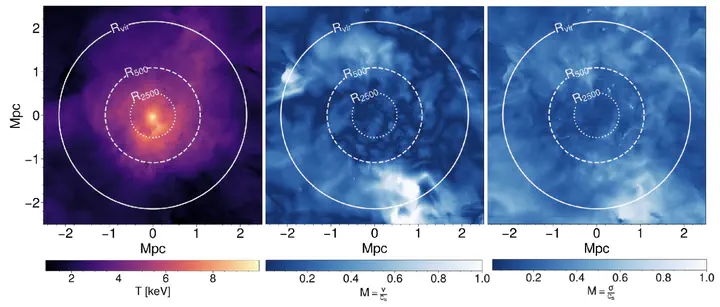
Abstract
Within the deep gravitational potential of galaxy clusters lies the intracluster medium (ICM). At the first order, it is considered to be at hydrostatic equilibrium within the potential well. However, evidence is growing on the observational side and in numerical simulations that the ICM dynamics is non-negligible from an energetic point of view, is mostly turbulent in origin, and provides a non-thermal pressure support to the equilibrium. In this work, we intend to characterise the properties of the velocity field in the ICM of a simulated replica of the Virgo cluster. We first study the 3D and projected properties of the ICM velocity field by computing its probability density functions (PDFs) and its statistical moments. We then estimate the non-thermal pressure fraction from an effective turbulent Mach number, including the velocity dispersion. We finally compute the velocity structure function (VSF) from projected maps of the sightline velocity. We first show that the components of the 3D velocity field and the projected quantities along equivalent sightlines are anisotropic and affected by the accretion of gas from filaments. Then, we compare the mean statistical moments of the 3D velocity field to the mean properties of a hundred random projections. We show, in particular, an almost linear relation between the standard deviation estimated from direct simulation outputs and sightline velocity dispersion projections, comparable to the line broadening of X-ray atomic lines. However, this linear relation does not hold between the direct simulation outputs and the standard deviation of the sightline velocity projections, comparable to the line shift of X-ray atomic lines. We find a non-thermal pressure fraction around 6% within R500 and 9% within Rvir from sightline velocity dispersion, which is in good agreement with direct simulation outputs. Finally, we show that the VSF might probe the Active Galactic Nuclei (AGN) feedback turbulent injection scale.